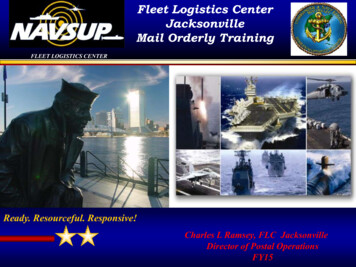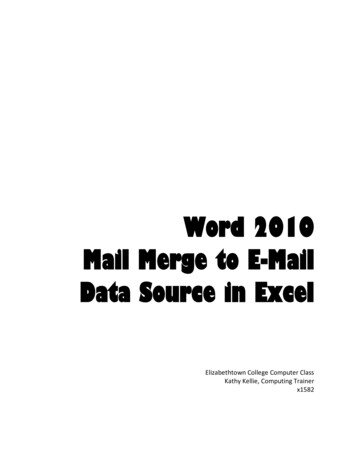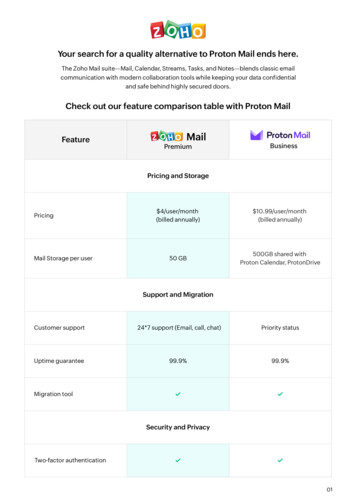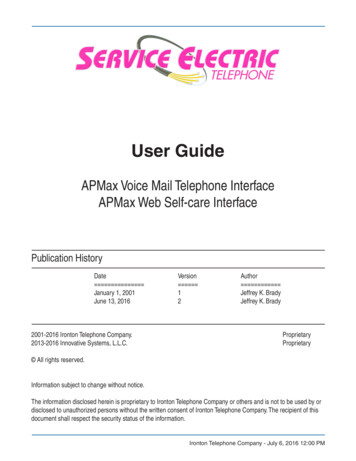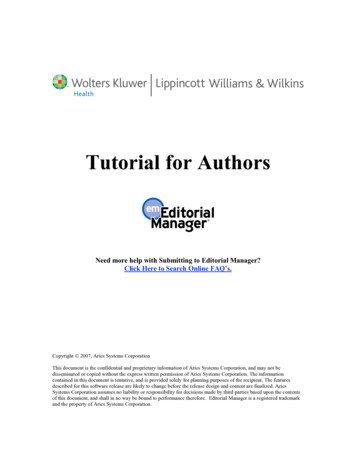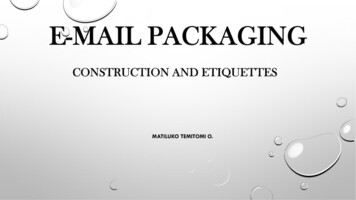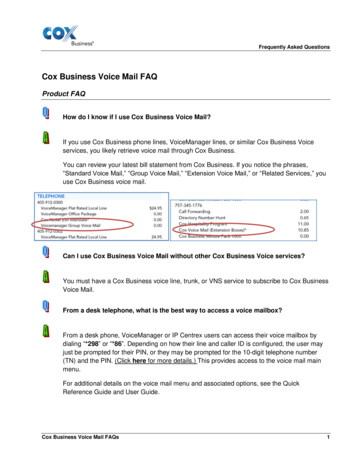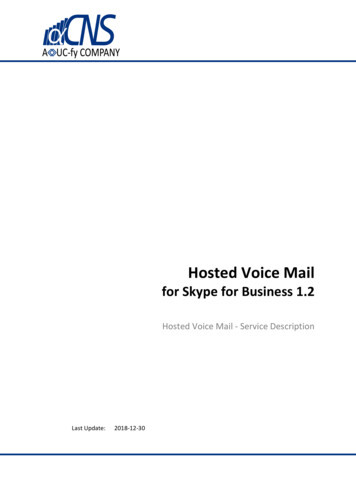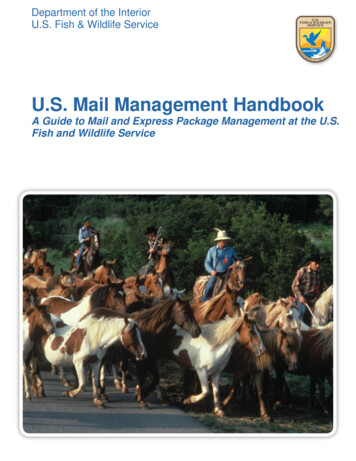
Transcription
Department of the InteriorU.S. Fish & Wildlife ServiceU.S. Mail Management HandbookA Guide to Mail and Express Package Management at the U.S.Fish and Wildlife Service
Table of ContentsTable of Contents . iiA Message from the Assistant Director - Business Management and Operations . ivContacting Your General Services Office . vA Note on the Examples Provided in the Handbook . viChapter 1: Purpose and Introduction . 11.1Defining Mail Management . 11.2Introducing Classes of Mail . 21.2.1 First-Class Mail and Priority Mail . 21.2.2 Periodicals . 31.2.3 Standard Mail . 31.2.4 International Mail. 31.2.5 Express Mail . 41.3Using Federal Express . 41.4Understanding Mailing Class Features . 5Chapter 2: Operational Guidelines. 62.1Managing Incoming Mail . 62.1.1 Processing Mail. 72.1.2 Managing and Updating Mail Stops . 72.1.2.1 Updating the Service Directory. 72.1.2.2 Updating Washington, DC Mail Stops (Washington Office employees only) . 82.1.3 Extenuating Circumstances . 92.2Managing Outgoing Mail . 102.2.1 Envelope and Package Preparation . 102.2.1.1 Sizing . 102.2.1.2 Addressing. 112.2.1.3 Placement. 112.2.2 Internal Mail Services (Intra- and Inter-Office Mail) . 13Chapter 3: Financial Processing and Penalty Mail. 163.1Paying for Postage . 163.1.1 Use of OMAS . 163.1.2 Postage Evidencing Systems . 163.1.2.1 Postage Meters . 173.1.2.2 Personal Computer Postage (PC Postage) . 203.1.3 Stamps . 213.1.4 Postage Rate Increases . 213.2Understanding Penalty Mail . 213.2.1 Defining Penalty Mail . 213.2.2 Using Penalty Mail . 223.2.2.1 Permit Imprint . 223.2.2.2 Penalty Reply Mail . 243.2.3 Allocating penalty mail costs . 25Chapter 4: Other Mail Services and Federal Express . 274.1Using USPS Special Services . 274.1.1 Bulk Mail . 274.1.2 Permit Imprint. 284.1.3 Business Reply Mail. 284.2Sending Mail and Packages by FedEx. 284.2.1 Initiating a FedEx Account . 28-ii-
4.2.2 Preparing FedEx Mail and Packages . 294.2.3 Determining when to use FedEx . 29Chapter 5: Security . 315.1Understanding Federal Security Guidelines . 315.2FWS Security Requirements . 315.3Conducting a Risk Assessment. 325.3.1 Step One: Asset and mission identification – what are you trying to protect? . 335.3.2 Step Two: Threat Assessment – what bad things could happen? . 335.3.3 Step Three: Vulnerability Assessment – what are your facility's weaknesses? . 345.3.4 Step Four: Impact Assessment – what if your security measures failed? . 355.3.5 Step Five: Risk Analysis – What does it all mean? . 365.4Developing Security Measures and Procedures . 37Appendix A: Mail Management Terms . 38Appendix B: Resources. 39Appendix C: Publication Coordinators . 40Appendix D: Special Attention Envelope Ordering Procedures . 41Appendix E: Cost Reduction Strategies . 42-iii-
Contacting Your General Services OfficeWhile this handbook should serve as your first source of information on the mail management process,you may encounter special circumstances not addressed in the handbook or U.S. Mail and ExpressPackage Policy (see 284 FW 1 through 3).The Service's Regional General Services offices are knowledgeable about mail policy and available toassist you with mail-related questions and issues. Use the contact information in the table below forassistance with the mail process.Region123456789ContactKristin YoungRey AragonCathy VanattaWanda PurdyLisa VirgilioBrian OstensonClaudette McDonaldKristin YoungJim 907-786-3439503-231-6259703-358-2264
A Note on the Examples Provided in theHandbookEach geographically-independent Service office or field station manages its own facility for the receipt,routing, and dispatch of mail, including express packages. Therefore, it is important for each facility todevelop its own set of procedures for day-to-day operations and maintenance. The procedures andprocesses for managing mail may vary based on factors such as the volume of mail, type of physicalfacility, or number of staff. For example, a large Regional office with multiple mail staff processinghundreds of mail pieces a day will require a more extensive assessment and plan than a field station withone mail staff person and few, if any, daily mail "runs." It is important to note that the examples providedin this handbook are for explanation only and that personnel in each office should determine the level ofmail management necessary for safe handling of their mail material.Guide to the Symbols in this handbook:ReferenceExample-vi-Hint
Chapter 1: Purpose and IntroductionThis section will help you answer the following questions: What is the purpose of this handbook? Who is the audience for this handbook? Which groups of Service employees have responsibilities during the mail managementprocess? What are the types of mail classes and how do they differ?1.1Defining Mail ManagementAll employees of the U.S. Fish and Wildlife Service have a responsibility to understand the guidancepertaining to mail policy and procedures. This handbook provides guidance to individuals who handle ormanage mail or express packages on behalf of the Service in any capacity. The handbook prescribes theService procedures and operational details for mail and express package management to assist Servicepersonnel in establishing and maintaining an effective mail operation within their areas of responsibility.Throughout the handbook, we offer suggestions for reducing costs (see summary in Appendix E).The Service's formal mail policy, Service Manual Part 284, is available online athttp://www.fws.gov/policy/manuals. This handbook serves as a reference guide for those employees whoneed detailed information on how to receive, process, or manage mail, or who need to understand mailrelated security procedures at Service facilities and offices.This handbook is a guide to assist Service employees in understanding relevant regulations, and doesnot replace or supersede the regulations. Employees should contact their Regional General Servicesoffices for guidance on any situations not covered in the handbook. Employees may also access theregulations and policies directly by using the following links:United States Postal Service (USPS) Domestic Mail Manual (DMM) – www.usps.govService Manual Part 284 – http://www.fws.gov/policy/manualsService Manual Part 432 (Physical Security in Service Facilities) http://www.fws.gov/policy/432fw1.htmlDepartment of the Interior (DOI) Departmental Manual (DM) 382, Chapter 2, Records Operations,Mail Management – http://elips.doi.gov/elips/release/3424.htmGeneral Services Administration (GSA) Security Plan – http://www.gsa.govGSA Mail Management Overview – http://www.gsa.gov/portal/content/104547GSA Federal Management Regulations, Sub Chapter G, Part 102-192 Mail Management rtment of Homeland Security (DHS) Interagency Security Committee (ISC) Physical Securityfor Federal Facilities – http://www.dhs.gov/files/committees/gc 1194978268031.shtm-1-
It is important to understand the distinction between a facility and an office. For our purposes, a mailfacility is any location where mail is sorted, delivered, picked up, or sent out. An office is a group ofService employees with a shared purpose in promoting the Service's mission.TermDefinitionFacilityOfficeExamplesRefuge (e.g., Martin National Wildlife Refuge)Hatchery (e.g., Bears Bluff National FishHatchery)Washington Office Arlington Headquarters(4301, 4401 and 4501 North Fairfax Drive)Northeast Regional Office (Region 5) inMassachusettsPhysical location where mail issorted, delivered, picked up orsent out; may be a field station oradministrative office. Multipleoffices may be located within thesame facility.Group of Service employees witha shared purpose in promotingthe Service's mission. Each officeis associated with one or morecost centers in the Service'sfinancial system.Exhibit 1.Office of External AffairsEndangered Species Program located in aspecific RegionWildlife and Sport Fish Restoration Programwithin a specific RegionDefinitions of Facility and OfficeAppendix A includes a full list of mail management terms and definitions.1.2Introducing Classes of MailThe USPS divides mail into different services, called "classes." Each class of mail has different features,service levels, postage prices, and presort requirements. For most mailings, the content of the materialand postage will determine the class of mail you select. The sections below highlight each of the mailclasses established in USPS regulations that the Service uses.The USPS Domestic Mail Manual (located at http://pe.usps.com/) contains more information aboutmailing classes and USPS services.1.2.1 First-Class Mail and Priority MailFirst-Class (also known as private correspondence) is the highest priority mail. This is the class Serviceemployees generally use to send correspondence, letters, and mailers.Typically, the USPS handles postcards, letter-size envelopes, flats (envelopes larger than letter size), andmail weighing more than 312 grams (11 ounces) as First-Class mail unless the sender requestsotherwise.Priority mail is First-Class mail that weighs over 13 ounces. Priority mail requires expeditious handlingand transportation, with a maximum weight of 70 pounds. The sender must place the word "Priority"prominently on each piece of mail in order to indicate that he / she would like to use this classItems that Service employees should mail as First-Class or Priority mail include handwritten or typewrittenmaterial, bills, statements of account of invoices, personalized correspondence, credit cards, and anymatter sealed against inspection.Be sure to prominently place the word "Priority" on each piece of mail that you wish to send using thePriority class (labels are available from the post office or can be printed from the USPS Web site).By using First-Class mail services, employees can also take advantage of the following additionalservices provided by the USPS:-2-
Registered Mail: USPS considers Registered Mail the most secure service that it offers.Registered Mail incorporates a system of receipts to monitor the movement of the mail from thepoint of acceptance to delivery. Registered Mail provides the sender with a mailing receipt and,upon request, electronic verification that an article was delivered or that a delivery attempt wasmade.Certified Mail: Certified Mail service provides the sender with a mailing receipt and, uponrequest, electronic verification that an article was delivered or that a delivery attempt was made.Insured Mail: Insured mail provides insurance against loss or damage.Certificate of Mailing: Certificate of Mailing serves as evidence that mail has been presented tothe USPS for mailing. It does not give you a record of delivery.Return Receipt: Return receipt service provides a mailer with evidence of delivery (to whom themail was delivered and date of delivery), along with information about the recipient's actualdelivery address.Delivery Confirmation: Delivery Confirmation service provides the mailer with information aboutthe date and time an article was delivered and, if delivery was attempted but not successful, thedate and time of the delivery attempt.Signature Confirmation: Signature Confirmation service provides the mailer with informationabout the date and time an article was delivered and, if delivery was attempted but notsuccessful, the date and time of the delivery attempt. A delivery record, including the recipient'ssignature, is maintained by the USPS and is available, via fax or mail, upon request.Special Handling: Special Handling service provides preferential handling, but not preferentialdelivery, to the extent practicable in dispatch and transportation. The service does not itself insurethe article against loss or damage. Special Handling service is mandatory for material thatrequires extra care in handling, transportation, and delivery.1.2.2 PeriodicalsThe Periodicals (formerly called Second-Class mail) designation is typically reserved for newspapers,magazines, and other publications where the sender's primary purpose is sending information to anestablished list of subscribers or requestors. The advent of electronic communications has drasticallyreduced the frequency with which we use the Periodicals class. The USPS must approve an applicationbefore we can mail newspapers or publications at periodical rates. If you think the Periodicals categoryapplies to your mailing, check with your local post office for additional details.1.2.3 Standard MailStandard mail (formerly called Third-Class mail) is any material that weighs less than 16 ounces and doesnot have to be mailed as First-Class or under the Periodicals class. Senders generally use Standard mailto send printed material, flyers, circulars, newsletters, bulletins, catalogs, and small parcels.All Standard mail rates are bulk rates and each mailing must meet a minimum quantity of 200 pieces or50 pounds (there are no single-piece rates). Although less expensive to mail than First-Class mail, it cantake from 7 to 10 days to send Standard mail across the U.S. versus 3 to 4 days for First-Class mail. Theprice of Standard mail does not include return service. Return service is available for an additional fee.Standard mail cannot be used for sending personal correspondence, handwritten or typewritten letters, orbills and statements of account.We typically do not send Standard mail. Please work with your Field Station Manager or Project Leader ifyou want to use the Standard mail class.1.2.4 International MailInternational mail includes material destined for foreign countries. International mail requires the sender toadhere to certain restrictions and use customs declaration forms. Employees who must send internationalmail should refer to the USPS International Mail Manual (IMM) to ensure that they meet all USPSrequirements. The IMM is available online at http://:pe.usps.gov. The correct international mail addressformat is shown in Exhibit 2.-3-
Exhibit 2.International Mail Address Format1.2.5 Express MailExpress mail provides shipment of time-sensitive packages and letters. Delivery is available to mostlocations every day of the year. For delivery the following day, senders must present express mail prior to5:00 P.M. at the express mail window of a post office offering this service. Please check with your localpost office to determine if they provide this service; rates, service details, and related information maychange periodically. Fees vary depending on the type of services selected, the distance the mail will besent, and the weight of the shipment. This class of mailing is the only way to provide overnight delivery tomailboxes and to P.O. boxes, and it is useful if you are trying to send a package or letter on short notice.The USPS provides free tracking information on each piece of express mail. You can track yourexpress mail by entering your tracking number in the USPS Track and Confirm .1.3Using Federal ExpressFederal Express (FedEx) provides express shipping services and is the preferred express package carrierof the Department of the Interior. Many of the Service's facilities offer Federal Express services to supportthe delivery of packages. Each Region or facility is responsible for the implementation and maintenanceof its FedEx contracts. In the Washington office, the FedEx courier drops off all packages directly to themail room. The mail room staff then screen and log each package and provide delivery directly to therecipient(s). Procedures may differ for other Regions.Chapter 4 of this handbook, Special Services, provides additional detail regarding the use of FedEx.-4-
1.4Understanding Mailing Class FeaturesExhibit 3 highlights the various features of each major mail class.Class of MailSpeedLow CostFreeForwardingand ReturnExpress MailYesNoYesYesNoPriority MailYesMaybeYesYesNoFirst-Class dard MailNoYesNoParcels OnlyYesPackage ServicesYesYesNoYesYesExhibit 3.SpecialServicesPre-sortDiscountsMail Classes (Source: USPS)Select the lowest cost class of mail that will get the mail to its destination in time to support theService's mission.-5-
Chapter 2: Operational GuidelinesThis chapter will help you answer the following questions: How does the Service manage incoming mail? How does the Service manage outgoing mail? How do I use intra- and inter-office mail? How do I handle extenuating circumstances like incorrectly addressed mail?2.1Managing Incoming MailThis section provides an overview of how the Service handles incoming mail, along with suggestions andtips for efficient routing. Each facility may have its own system or set of procedures based on the size andlocation of staff and departments.A Facility Manager or Project Leader who has facility operational responsibilities must incorporate mailpolicy requirements and guidance into any site-specific mail procedures.Incoming mail is any mail received from the USPS and other couriers (e.g., FedEx) for distribution anddelivery throughout the Service. Mail staff should sort and deliver incoming mail in a timely manner uponreceiving it.Each facility must establish an internal mail service that supports their needs. Examples of mailarrangements include the following:Dedicated Service mail room (mail room serves one or many Service locations – e.g., mailroomat 4401 North Fairfax Drive in Arlington, VA serving multiple Arlington facilities)Dedicated DOI mail room (the Service shares mail room with other DOI Bureaus – e.g., mailroomat DOI Main Interior Building)Shared mail room (multiple Federal agencies in the same building share a mail room)No formal mail room (mail sorted and distributed in an office or open area -- e.g., a small refuge)The procedures in each facility vary, depending on the size of the office and the types of services that themail room staff provides. The mail service should provide such services as sorting and delivering mail,preparing mail for pickup, and distributing interoffice mail. To expedite delivery, the sender should providethe recipient‘s name, office, and mail stop. (See 2.1.2 for information on mail stops.)Mail service "runs," or deliveries should coincide with the USPS delivery and pickup times. To makecertain that the mail is processed or rerouted the same day, we recommend that mail staff complete aminimum of two mail runs each day. The mail staff should complete at least one mail run in the morningand another in the afternoon. Some offices may require additional runs because of heavier mail volume.Each Project Leader or Facility Manager should document and publish how messages and otherdocuments move within the facility. This documentation should include the following items:Assigned time of scheduled tripsNumber of trips that the mail staff complete each dayLength of time it takes for a member of the mail staff to complete a tripCut-off times for mail pickup by the USPSProtocols for maintaining a record of any problems (e.g., mis-delivered mail, damaged mail,employees who have left the Service)-6-
Each office should review this process annually to identify and eliminate any problems and to ensure thatthey are providing efficient internal mail service.2.1.1 Processing MailEach office or facility should prepare written instructions for processing incoming mail that are userfriendly and can be clearly understood by mailroom staff and other personnel who handle mail. At aminimum, the instructions should address the following topics:How to collect and distribute incoming mailHow to handle incorrectly delivered and returned mailHow to process electronically-transmitted messages such as facsimile and telegramtransmissionsEach facility that processes incoming mail should ensure that the operating times of the mail room, orhours of the mail room staff, are clearly noted and distributed to all employees. Some facilities (e.g., asmall refuge) may only require one staff member to take a few minutes to distribute mail each day, whileother facilities (e.g., the Service's Arlington offices) may have a dedicated mail room with multiple full-timestaff members. The Facility Manager must determine what level of instruction best fits the needs of thefacility.In addition to operating times, the Facility Manager should formally determine the routing process andprocedure for incoming mail by asking the following questions:Where and how will mailroom employees distribute incoming mail and packages? To mail slots orcubbies? Directly to employees? To administrative staff?How many times per day will mail staff deliver mail to individuals or offices?Who will sign for and deliver packages?Developing thoughtful procedures will help make processing incoming mail efficient and effective andreduce the number of errors and redirection of mail pieces.Remember that express packages may require signature upon delivery. Build a procedure into youroffice's mail delivery process for handling express mail signatures.2.1.2 Managing and Updating Mail StopsThe term ‗mail stop‘ is used to identify a location internally. Internal mail requires a four-digit mail stop toexpedite delivery. Senders must use mail stop codes in the return address of all outgoing mail. Eachfacility must assign mail stop codes according to guidelines already established by the mail manager.Regional offices should develop a process for assigning and maintaining mail stops. Contact yourRegional General Services office for more information on your Region.Facility Managers should establish a mail stop for ten or more employees receiving mail at a location.2.1.2.1Updating the Service DirectoryEmployees should add their mail stops in their Service profiles by completing the following steps:Go to the Service Intranet (http://inside.fws.gov).Click on "My Profile."Update your street address to include your mail stop.-7-
Exhibit 4.2.1.2.2Service ProfileUpdating Washington, DC Mail Stops (Washington Office employees only)The Correspondence Control Unit (CCU) manages the Service mail stop routing list for the WashingtonOffice (WO). Employees should contact CCU at (202) 208-7248 to report mail stop changes or additionsin the WO. Exhibit 5 below shows an excerpt from a WO routing slip. Visit http://www.fws.gov/forms/31936.pdf to obtain a current version of the routing slip.Exhibit 5.Mail Excerpt from Routing Slip (Washington Office)-8-
2.1.3 Extenuating CircumstancesEven in the most efficiently run offices, circumstances may occur that inhibit our ability to effectivelymanage mail. The most common extenuating circumstances are listed below.Opening Mail: The Service typically distributes mail unopened unless we have to open it toidentify the recipient, conduct an official law enforcement investigation, or address securityconcerns. When necessary, open the mail to locate and verify the intended recipient. Then,attach the full address of the sender to the now-opened envelope for delivery. Do not opensuspicious mail under any circumstance—contact your security officer or the appropriate lawenforcement official immediately. See Chapter 5 for more information on security considerations.Mis-delivered Mail: If mail is sent to the wrong office, the individual office / facility mustdetermine whether to send the mail back to the USPS as undeliverable or to route it to the correctlocation. If you locate a piece of mis-delivered mail, consider the points listed below andillustrated in Exhibit 6.– Use the Lotus Notes directory (see Section 2.1.2) or the DOI Directory to determine the recipient'slocation. If you can identify and locate the Service recipient, re-route the mail via internal mailservices (Section 2.2.2).– If you cannot determine the recipient's location but the mail is addressed to the U.S. Fish andWildlife Service, open the mail to identify the recipient. Then, attach the full address of the senderto the now-opened envelope for delivery. (Note that any mail addressed to the Service becomesthe property of the Service and can be opened if needed.)– If the mail is not addressed to the Service or you cannot determine
Which groups of Service employees have responsibilities during the mail management process? What are the types of mail classes and how do they differ? 1.1 Defining Mail Management All employees of the U.S. Fish and Wildlife Service have a responsibility to understand the guidance pertaining to mail policy and procedures.
